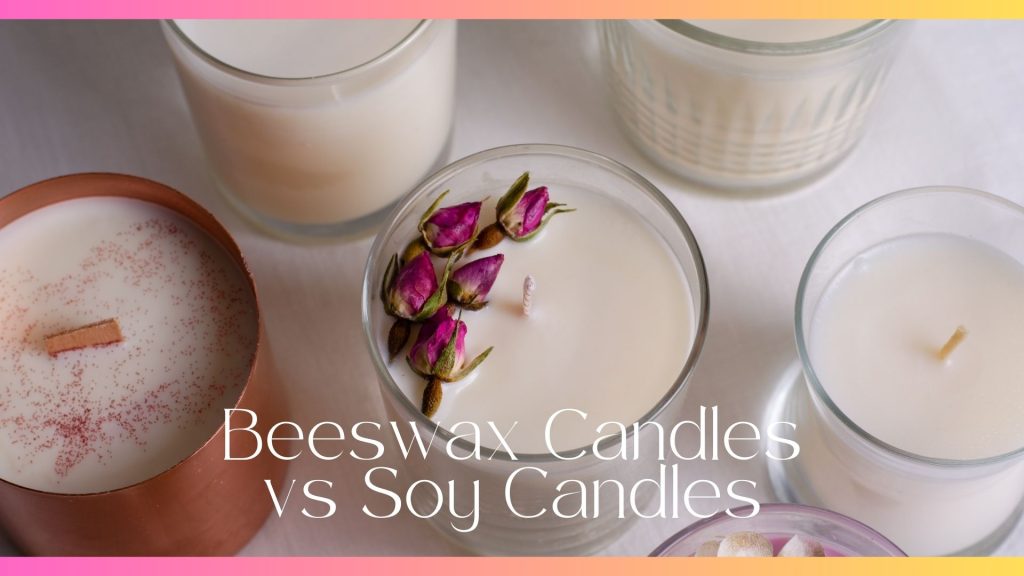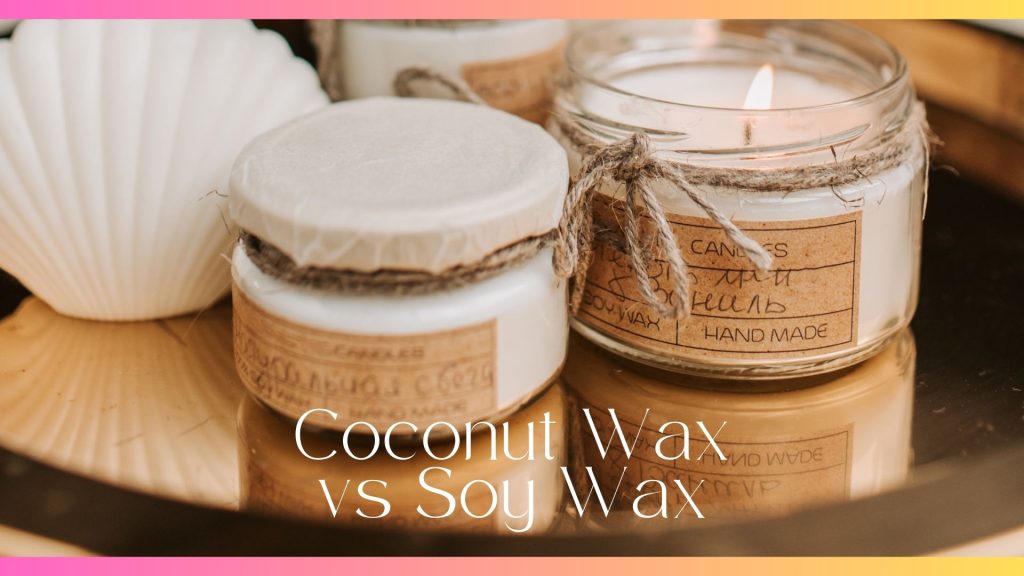Comparing coconut wax vs paraffin wax for candle-making? Here’s everything you should know before deciding which one is the right one for you.
In this article, I’ll discuss the differences between coconut wax and paraffin wax, including what makes them a good wax option for candle-making.
Disclaimer: This post may contain affiliate links. This means I may earn a small commission (at no cost to you) if you sign up for a program or make a purchase using my link!
Related Posts:
- Soy Candles vs Coconut Candles for Candle-making
- How To Make Coconut Wax Candles with Essential Oils
- How Long Do Coconut Wax Candles Need To Cure?
Overview of Candle Wax Types
The primary ingredient to make candles is candle wax. There are a few types of candle wax you can use to create candles even by yourself from home.
Each type of wax has its own unique properties, as well as benefits and drawbacks. Understanding the different kinds will make it easier for you to choose one that’s best for your business or hobby.
If this is your first time making candles, it’s good to know that candle wax is a solid material that becomes liquid when heated and re-solidifies upon cooling. It holds the candle’s shape, fragrance and fuels the flame with a candle wick. The type of wax you use affects the candle’s performance and appearance.
The most common types of candle wax include paraffin wax, soy wax, beeswax, coconut wax, and palm wax. Each type has unique properties that influence how the candle burns, its scent throw, and its environmental impact.
What is Coconut Wax?
Coconut wax is made from hydrogenated coconut oil. It’s a natural and renewable resource and is preferred by candle-makers due to their excellent candle burning performance and eco-friendliness.
Benefits of Coconut Wax
- Eco-friendly: Coconut wax is sustainable and biodegradable.
- Excellent scent throw: It disperses fragrance effectively.
- Long burn time: Coconut wax candles tend to burn longer.
- Smooth texture: It has a creamy and luxurious appearance.
Drawbacks of Coconut Wax
- Cost: It is generally more expensive than other waxes.
- Availability: It can be harder to find compared to more common waxes.
- Lower melting point: This can be an issue in warmer climates.
What is Paraffin Wax?
Paraffin wax is a byproduct of the petroleum refining process. It is widely used in candle-making due to its low cost and ease of use.
Benefits of Paraffin Wax
- Affordable: Paraffin wax is one of the most cost-effective options.
- Versatile: It can be used in various candle types.
- Good scent throw: It holds and releases fragrance well.
- Availability: Readily available in most markets.
Drawbacks of Paraffin Wax
- Environmental impact: It is not biodegradable and is derived from non-renewable resources.
- Health concerns: Can release harmful chemicals when burned.
- Soot production: Produces more soot compared to natural waxes.
Key Differences Between Coconut Wax and Paraffin Wax
The table below should provide a comprehensive comparison of coconut wax and paraffin wax when used for candle-making.
| Aspect | Coconut Wax | Paraffin Wax |
|---|---|---|
| Source | Derived from refined coconut oil | Derived from petroleum, a byproduct of crude oil refining |
| Sustainability | Eco-friendly, biodegradable, renewable | Non-renewable, derived from fossil fuels |
| Burn Quality | Burns cleanly with minimal soot | Burns with more soot and potential toxins |
| Scent Throw | Excellent scent throw, holds fragrance well | Good scent throw, but not as natural-smelling as coconut wax |
| Texture | Smooth and creamy | Smooth and can be more rigid |
| Melting Point | Lower melting point, around 100-110°F (38-43°C) | Higher melting point, around 120-160°F (49-71°C) |
| Burn Time | Long burn time, consistent burn | Varies, often shorter burn time than coconut wax |
| Color | Naturally white, can be colored easily | Naturally white or off-white, can be colored |
| Fragrance Compatibility | Compatible with a wide range of fragrance oils and essential oils | Compatible with most fragrance oils, but may affect scent purity |
| Environmental Impact | Low impact, supports sustainable agriculture | Higher impact due to fossil fuel extraction |
| Use in Candle Making | Ideal for container candles, smooth finish | Versatile, used in various candle types (containers, pillars, etc.) |
| Availability | Growing in popularity, becoming more widely available | Widely available and commonly used |
| Cost | Generally higher due to production processes | Typically lower cost, more economical |
| Health Concerns | Non-toxic, safe for indoor air quality | Potential health concerns due to soot and chemical emissions |
In summary, coconut wax is a highly sustainable product to work with as coconuts are a renewable resource that’s also biodegradable. As paraffin wax is derived from petroleum, it is non-renewable and its production & disposal contributes to environmental pollution (not biodegradable).
When made as candles, coconut wax candles are non-toxic and burns cleanly, making them ideal for indoor use. We can’t say the same for paraffin candles as they release harmful chemicals like toluene and benzene when burned, which can affect indoor air quality.
Coconut wax candles also produces very little soot, keeping your air cleaner and your candle containers free from black residue – unlike paraffin candles which does the direct opposite.
If you’re concerned about the candle’s performance, coconut wax candles have a longer burn time and a better scent throw when made into scented candles. Coconut wax is also more aesthetically pleasing, thanks to its smooth, creamy appearance that looks more luxurious.
Of course when comparing prices, coconut wax is more expensive than paraffin wax due to its high quality and sustainable sourcing.
Paraffin Wax vs Soy Wax for Candle-making
Although paraffin wax is still widely used today especially among commercial businesses, the demand for sustainable alternatives like soy wax has been growing steadily. It is another renewable and biodegradable resource that’s comparable to coconut wax.
Soy wax are largely used for candle-making as it is one of the cheaper eco-friendly options, even when comparing with coconut wax or palm wax. Unlike paraffin wax, soy wax burns cleanly, produces minimal soot and is ideal for indoor use.
Although it has a slightly weaker scent throw compared to paraffin, it can still produce beautifully fragrant candles with the right fragrance oils and proper wick selection. Overall, soy wax is often preferred for its environmental benefits and cleaner burn, while paraffin wax may still be chosen for its cost-effectiveness and strong scent throw.
What is the Healthiest Wax for Candles?
Beeswax is widely regarded as the healthiest wax for candles. Aside from being a natural, renewable resource that burns cleanly and produces very little soot, beeswax candles can even help purify the air by releasing negative ions which remove pollutants and allergens from the air.
Unlike other waxes that may require additional fragrances, beeswax has a natural honey scent and does not require added fragrances or chemicals.
If you’re not interested in beeswax as it is not vegan, you can consider coconut wax, which also burns cleanly and is free from harmful toxins and pollutants. Both beeswax and coconut wax are excellent choices for someone looking for a healthier wax.
Read: Key differences between beeswax candles and soy candles
Best Wax for Scented Candles
The best wax for scented candles is coconut wax as it has a superior scent throw and the ability to hold fragrance oils effectively. Coconut wax burns slowly and evenly, which enhances the diffusion of scent throughout a space.
If coconut wax is beyond your budget, soy wax is a common choice for making scented candles. It does however require a higher percentage of fragrance oil to achieve the desired intensity. Blending coconut wax with soy wax can combine the best attributes of both, resulting in long-lasting, highly fragrant candles.
Bottom Line
Both coconut wax and paraffin wax have their own sets of benefits and drawbacks. Coconut wax is excellent for those who prioritize eco-friendliness and a strong scent throw, while paraffin wax is perfect for those looking for affordability and versatility.
I would recommend that you use coconut wax if you’re looking to appeal to today’s eco-conscious consumer and do your part as a candle-maker for a greener future.
Frequently Asked Questions (FAQs)
Coconut wax is often considered better than paraffin wax for several reasons. It is a natural, renewable resource derived from coconut meat, making it an eco-friendly option. Coconut wax burns cleanly, producing minimal soot and reducing indoor air pollution, unlike paraffin wax, which is a petroleum byproduct that can release harmful chemicals when burned. Additionally, coconut wax has an excellent scent throw and a longer burn time, providing a more enjoyable and longer-lasting candle experience. Its smooth, creamy texture holds color well, adding to the candle’s aesthetic appeal. However, coconut wax is generally more expensive and less widely available than paraffin wax.
The best wax for candle making depends on your priorities, such as sustainability, cost, and performance. Soy wax is popular due to its clean burn, long burn time, and affordability, making it ideal for beginners. Coconut wax is prized for its excellent scent throw, clean burn, and luxurious appearance, but it is more expensive and softer, often requiring blending with harder waxes. Beeswax offers a natural, pleasant scent and air-purifying properties but is costly and not vegan-friendly. Palm wax has a unique crystalline appearance and burns cleanly, but its sustainability depends on ethical sourcing. Paraffin wax is inexpensive and widely available but can release harmful chemicals.
You can make candles with 100% coconut wax. Coconut wax is a versatile and high-performing wax that offers a clean burn, excellent scent throw, and a smooth, creamy appearance. However, due to its softness and low melting point, it can sometimes be challenging to work with on its own. To address this, many candle makers blend coconut wax with harder waxes, such as soy or beeswax, to improve the candle’s structural integrity and burning characteristics. Using 100% coconut wax can result in luxurious, high-quality candles with a long burn time and minimal soot production.
Paraffin wax is a popular choice for candles due to its affordability, availability, and excellent scent throw. It is a versatile wax that can be easily colored and scented, making it a favorite among many candle makers. Paraffin wax also has a higher melting point, which helps candles maintain their shape and provides a longer burn time. However, it is derived from petroleum, a non-renewable resource, and can release harmful chemicals, such as toluene and benzene, when burned. These emissions can contribute to indoor air pollution and respiratory issues. Those concerned with environmental impact and health may prefer natural alternatives like soy, coconut, or beeswax.


